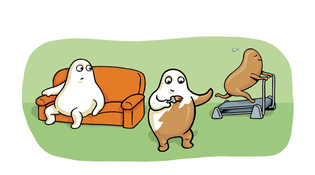 loading
loading
FindingsWhite fat, brown fatYour bad fat will turn into good fat—if your brain cooperates.  Gregory NemecView full imageIt’s the dieter’s Holy Grail: brown fat, a type of fat in everyone’s body that converts energy to heat. The dieter’s enemy, on the other hand, is white fat, the type that stores energy and inflates waistlines. The ratio of energy-burning fat to energy-storing fat can determine our weight and how healthy we are. Under certain circumstances, white fat can be converted to “brown-like” fat, which also burns energy—but something regulates that process, sometimes slowing it enough to cause obesity. Now, researchers at the Yale School of Medicine have identified that something. Their findings were published in the October 9 issue of the journal Cell. “Little was known about how the brain controlled this process,” says Xiao-yong Yang, associate professor of comparative medicine and physiology, who conducted the study. “We were able to identify what kind of neurons control this transformation. They are called the ‘hunger neurons’”—already known to cause the sensation of hunger during fasting. Yang and his colleagues showed that, in mice, fasting slows the browning process, thereby allowing the body to store energy during food shortages. They also found that genetically engineering mice to fire up their hunger neurons had the same effect—confirming the critical role of the neurons. Finally, they identified the precise enzyme and the molecular process within the neurons that work to suppress browning. “It is our hope that drug development based on our discovery will help to fight obesity and improve human health,” says Yang.
The comment period has expired.
|
|